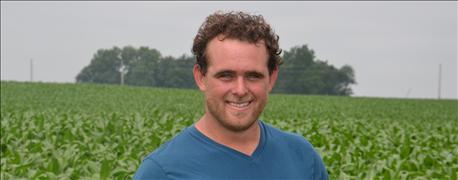
What seemed like a perfect opportunity to use cover crops for the first time turned out to be a flop. But that didn’t stop Gerrett Dobson, Rensselaer, from trying again. He farms with a partner, Gary Streitmatter.
Back in 2012, drought severely impacted some of Dobson’s corn. Some of it was chopped for silage. He decided to come back with cover crops since otherwise the soil would be bare for a long time. In fact, he put out a cover crop plot and drilled the bulk of the acres to radishes and annual ryegrass.

DETERMINED: One bad experience didn’t stop Gerrett Dobson from trying cover crops again.
“I had a poor experience with it,” Dobson recalls. “The radish went to seed early because it was a bad lot of seed which had wild-type radish in it. In the end, I had trouble controlling the cover crops.”
The experience was so disheartening that Dobson took a year off from cover crops. “If someone wants you to talk about cover crops and only talk about the good things, you need to be wary of that situation,” he says. “There can be a downside, too, and people need to be aware of that, as well.”
Second chance
Daniel Perkins works for the Jasper County Soil and Water Conservation District. He is also an Indiana Certified Crop Adviser. Some people in the area call him the "cover crop guy." He believes in cover crops so much that he continually urges farmers to try them. He didn’t give up even after Dobson had a poor experience his first time out.
“I came back with cereal rye on sandy ground the next time I tried it,” Dobson says. Now he’s trying whole fields again. He grows mint and has also used cover crops in his mint fields.
His method of choice now is broadcasting cereal rye after combining. He has run a Great Plains Turbo Till after seeding on some fields to help incorporate the seed into the soil. Dobson says his goal is to apply 45 to 50 pounds of cereal rye seed per acre. He typically spends around $12 per acre on the rye seed, plus the cost of spreading.
Good year
Dobson saw excellent spring growth of cereal rye in 2016. His goal is to burn it down before it gets too tall. That’s the trick with cereal rye, Perkins says — catching it at the right time in the spring.
Dobson was able to burn down the rye before planting in 2016. He says he caught most of it at about knee-high stage. In places where wet weather prevented spraying, some people wound up planting into very tall rye and then killing it. Many still reported good results.
Dobson used cereal rye primarily ahead of soybeans this year. However, he also planted corn after rye in some fields.
Is he glad he gave cover crops a second chance? “We are catching nutrients with them for sure,” he says. And they are holding soil in place where it tends to blow or wash in his area.
“We’re also adding organic matter,” Dobson continues. “After three or four years, you can begin to see it. You can definitely see a yield increase.”
About the Author(s)
You May Also Like




